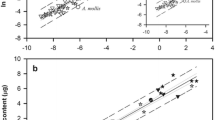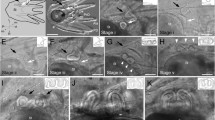Abstract
Rates of respiration and protein synthesis were measured during embryonic and larval development of Antarctic asteroids with different life-history modes (non-feeding and feeding larvae: Acodontaster hodgsoni, Porania antarctica, Odontaster meridionalis). Patterns of respiration for these species all show an increase during embryogenesis, with subsequent maintenance of routine respiration (“starvation resistance”), even in the absence of food for ~4 months (O. meridionalis). Fractional rates of protein synthesis (i.e., rate per unit mass of whole-body protein content) in the Antarctic larvae are essentially identical to those of temperate species. Larvae of O. meridionalis had an average fractional synthesis rate of 0.52% ± 0.05 h−1 at −1.0°C, which is comparable to the temperate asteroid Asterina miniata at 0.53% ± 0.14 h−1 at 15°C. For embryos of the asteroids A. hodgsoni and P. antarctica, fractional rates of protein synthesis (~0.2% h−1) also are comparable to those reported for embryos of temperate echinoderm species. While rates of synthesis are high, rates of protein deposition are relatively low (percent of protein synthesized that is retained for growth). During a ~4 month growth period for larvae of O. meridionalis, the average protein depositional efficiency was 5.2%. This contrasts with higher rates of depositional efficiency reported for similar developmental stages of temperate echinoderm species. The biological significance of maintaining high rates of macromolecular synthesis for species with low rates of cell division and low protein depositional efficiencies is intriguing in the context of understanding the mechanistic bases of extended life spans and dispersal potential in response to changing Antarctic environments.





Similar content being viewed by others
References
Berg WE, Mertes DH (1970) Rates of synthesis and degradation of protein in the sea urchin embryo. Exp Cell Res 60:218–224
Bosch I (1989) Contrasting modes of reproduction in two Antarctic asteroids of the genus Porania, with a description of unusual feeding and non-feeding larval types. Biol Bull 177:77–82
Bosch I, Pearse JS (1990) Developmental types of shallow-water asteroids in McMurdo Sound, Antarctica. Mar Biol 104:41–46
Bosch I, Beauchamp KA, Steele ME, Pearse JS (1987) Development, metamorphosis, and seasonal abundance of embryos and larvae of the Antarctic sea urchin Sterechinus neumayeri. Biol Bull 173:126–135
Broad WJ (1998) The universe below: discovering the secrets of the deep sea. Simon and Schuster, New York
Clark HES (1963) The fauna of the Ross sea. Part 3. Asteroidea. NZ Dept Sci Ind Res Bull 151:1–84
Clarke A, Fraser KPP (2004) Why does metabolism scale with temperature? Funct Ecol 18:243–251
Davidson EH (1976) Gene activity in early development, 2nd edn. Academic Press, New York
Davidson EH (1986) Gene activity in early development, 3rd edn. Academic Press, Florida
Dayton PK, Robilliard GA, Paine RT, Dayton LB (1974) Biological accommodation in the benthic community at McMurdo Sound, Antarctica. Ecol Monogr 44:105–128
Epel D (1967) Protein synthesis in sea urchin eggs: A ‘late’ response to fertilization. Proc Nat Acad Sci 57:899–906
Fraser KPP, Rogers AD (2007) Protein metabolism in marine animals: the underlying mechanism of growth. Adv Mar Biol 52:267–362
Fraser KPP, Clarke A, Peck LS (2002) Low-temperature protein metabolism: seasonal changes in protein synthesis and RNA dynamics in the Antarctic limpet Nacella concinna Strebel 1908. J Exp Biol 205:3077–3086
Fraser KPP, Clarke A, Peck LS (2007) Growth in the slow lane: protein metabolism in the Antarctic limpet Nacella concinna (Strebel 1908). J Exp Biol 210:2691–2699
Fry BJ, Gross PR (1970) Patterns and rates of protein synthesis in sea urchin embryos. II. The calculation of absolute rates. Dev Biol 21:125–146
Gilbert SF (2006) Developmental biology, 8th edn. Sinauer Associates, Massachusetts
Gillespie JM, McClintock JB (2007) Brooding in echinoderms: How can modern experimental techniques add to our historical perspective? J Exp Mar Biol Ecol 342:191–201
Goustin AS, Wilt FH (1981) Protein synthesis, polyribosomes, and peptide elongation in early development of Strongylocentrotus purpuratus. Dev Biol 82:32–40
Hawkins AJS (1991) Protein turnover: a functional appraisal. Funct Ecol 5:222–233
Hochachka PW, Somero GN (2002) Biochemical adaptation: mechanism and process in physiological evolution. Oxford University Press, Oxford, UK
Hoegh-Guldberg O, Emlet RB (1997) Energy use during the development of a lecithotrophic and a planktotrophic echinoid. Biol Bull 192:27–40
Houlihan DF, Hall SJ, Gray C, Noble BS (1988) Growth and protein turnover in Atlantic cod, Gadus morhua. Can J Fish Aquat Sci 45:951–964
Houlihan DF, Waring CP, Mathers E, Gray C (1990) Protein synthesis and oxygen consumption in the shore crab Carcinus maenas after a meal. Physiol Zool 63:735–756
Jaeckle WB, Manahan DT (1989) Growth and energy imbalance during the development of a lecithotrophic molluscan larva (Haliotis refescens). Biol Bull 177:237–246
Leong PKK, Manahan DT (1999) Na+/K+ ATPase activity during early development and growth of an Antarctic sea urchin. J Exp Biol 202:2051–2058
Manahan DT (1983) The uptake and metabolism of dissolved amino acids by bivalve larvae. Biol Bull 164:236–250
Mark FC, Hirse T, Pörtner HO (2005) Thermal sensitivity of cellular energy budgets in some Antarctic fish hepatocytes. Polar Biol 28:805–814
Marsh AG, Manahan DT (1999) A method for accurate measurements of the respiration rates of marine invertebrate embryos and larvae. Mar Ecol Prog Ser 184:1–10
Marsh AG, Leong PKK, Manahan DT (1999) Energy metabolism during embryonic development and larval growth of an Antarctic sea urchin. J Exp Biol 202:2041–2050
Marsh AG, Maxson RE, Manahan DT (2001) High macromolecular synthesis with low metabolic cost in Antarctic sea urchin embryos. Science 291:1950–1952
McClintock JB, Pearse JS, Bosch I (1988) Population structure and energetics of the shallow-water Antarctic sea star Odontaster validus in contrasting habitats. Mar Biol 99:235–246
Moore M, Manahan DT (2007) Variation among females in egg lipid content and developmental success of echinoderms from McMurdo Sound, Antarctica. Polar Biol 30:1245–1252
Moreno G, Hoegh-Guldberg O (1999) The energetics of development of three congeneric seastars (Patiriella Verrill, 1913) with different types of development. J Exp Mar Biol Ecol 235:1–20
Pace DA, Manahan DT (2006) Fixed metabolic costs for highly variable rates of protein synthesis in sea urchin embryos and larvae. J Exp Biol 209:158–170
Pace DA, Manahan DT (2007a) Cost of protein synthesis and energy allocation during development of Antarctic sea urchin embryos and larvae. Biol Bull 212:115–129
Pace DA, Manahan DT (2007b) Efficiencies and costs of larval growth in different food environments (Asteroidea: Asterina miniata). J Exp Mar Biol Ecol 353:89–106
Pearse JS (1969) Slow developing demersal embryos and larvae of the Antarctic sea star Odontaster validus. Mar Biol 3:110–116
Pearse JS (1994) Cold-water echinoderms break Thorson’s rule. In: Young CM, Eckelbarger KJ (eds) Reproduction, larval biology and recruitment in deep-sea benthos. Columbia University, New York, pp 26–43
Pearse JS, Lockhart SJ (2004) Reproduction in cold water: paradigm changes in the 20th century and a role for cidaroid sea urchins. Deep-Sea Res II 51:1533–1549
Pearse JS, McClintock JB, Bosch I (1991) Reproduction of Antarctic marine invertebrates: tempos, modes and timing. Am Zool 31:65–80
Peck LS (2002) Ecophysiology of Antarctic marine ectotherms: limits to life. Polar Biol 25:31–40
Peck LS, Prothero-Thomas E (2002) Temperature effects on the metabolism of larvae of the Antarctic starfish Odontaster validus, using a novel microrespirometry method. Mar Biol 141:271–276
Peck LS, Convey P, Barnes DKA (2006) Environmental constraints on life histories in Antarctic ecosystems: tempos, timings, and predictability. Biol Rev 81:75–109
Peck LS, Powell DK, Tyler PA (2007) Very slow development in two Antarctic bivalve molluscs, the infaunal clam Laternula elliptica and the scallop Adamussium colbecki. Mar Biol 150:1191–1197
Pörtner HO (2006) Climate-dependent evolution of Antarctic ectotherms: An integrative analysis. Deep-Sea Res II 53:1071–1104
Pörtner HO, Farrell AP (2008) Physiology and climate change. Science 322:690–692
Pörtner HO, Peck L, Somero G (2007) Thermal limits adaptation in marine Antarctic ectotherms: an integrative view. Phil Trans R Soc B 362:2233–2258
R Development Core Team (2005) R: A language and for statistical computing. R Foundation for Statistical Computing, Vienna, Austria, http://www.R-project.org
Regier JC, Kafatos FC (1977) Absolute rates of protein synthesis in sea urchins with specific activity measurements of radioactive leucine and leucyl-tRNA. Dev Biol 57:270–283
Robertson RF, El-Haj AJ, Clarke A, Peck LS, Taylor EW (2001) The effects of temperature on metabolic rate and protein synthesis following a meal in the isopod Glyptonotus antarcticus Eights (1852). Polar Biol 24:677–686
Shilling FM, Manahan DT (1994) Energy metabolism and amino acid transport during early development of Antarctic and temperate echinoderms. Biol Bull 187:398–407
Sokal RR, Rohlf FJ (1995) Biometry, 3rd edn. WH Freeman and Company, New York
Stanwell-Smith DP, Peck LS (1998) Temperature and embryonic development in relation to spawning and field occurrence of larvae of 3 Antarctic echinoderms. Biol Bull 194:44–52
Storch D, Pörtner HO (2003) The protein synthesis machinery operates at the same expense in eurythermal and cold stenothermal pectinids. Physiol Biochem Zool 76:28–40
Storch D, Heilmayer O, Hardewig I, Pörtner HO (2003) In vitro protein synthesis capacities in a cold stenotherm and a temperate eurythermal pectinid. J Comp Physiol B 173:611–620
Storch D, Lannig G, Pörtner HO (2005) Temperature-dependent protein synthesis capacities in Antarctic and temperate (North sea) fish (Zoarcidae). J Exp Biol 208:2409–2420
Strathmann RR, Kendall LR, Marsh AG (2006) Embryonic and larval development of a cold adapted Antarctic ascidian. Polar Biol 29:495–501
Torres JJ, Somero GN (1988) Metabolism, enzymatic activities and cold adaptation in Antarctic mesopelagic fishes. Mar Biol 98:169–180
Vavra J, Manahan DT (1999) Protein metabolism in lecithotrophic larvae (Gastropoda: Haliotis refescens). Biol Bull 196:177–186
Whiteley NM, Taylor EW, El Haj AJ (1996) A comparison of the metabolic cost of protein synthesis in stenothermal and eurythermal isopod crustaceans: Effects of temperature. Comp Biochem Physiol 128:595–606
Acknowledgments
We thank Drs. Doug Pace, Allison Green, and Michael Moore for assistance with rearing larvae over many months while working at McMurdo Station, Antarctica. Dr. Robert Maxson provided very insightful advice and suggestions. Special thanks to Rob Robbins for his assistance with animal collections in the field, and to the Crary Laboratory staff for help with this research. This work was supported by the National Science Foundation under Grant No. 01-30398.
Conflict of interest statement
The authors declare that they have no conflict of interest.
Author information
Authors and Affiliations
Corresponding author
Additional information
Communicated by H. O. Pörtner.
Rights and permissions
About this article
Cite this article
Ginsburg, D.W., Manahan, D.T. Developmental physiology of Antarctic asteroids with different life-history modes. Mar Biol 156, 2391–2402 (2009). https://doi.org/10.1007/s00227-009-1268-0
Received:
Accepted:
Published:
Issue Date:
DOI: https://doi.org/10.1007/s00227-009-1268-0




